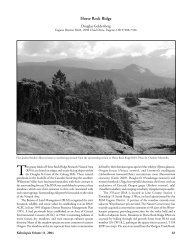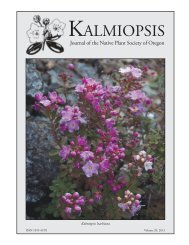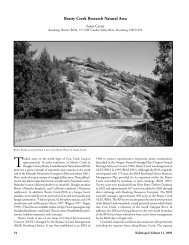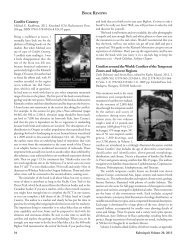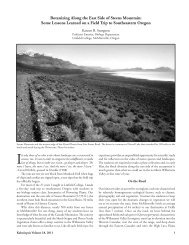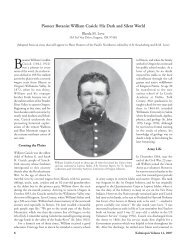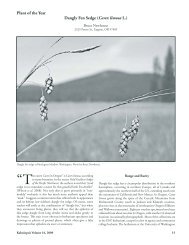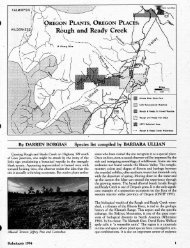Henderson's Checkermallow - Native Plant Society of Oregon
Henderson's Checkermallow - Native Plant Society of Oregon
Henderson's Checkermallow - Native Plant Society of Oregon
You also want an ePaper? Increase the reach of your titles
YUMPU automatically turns print PDFs into web optimized ePapers that Google loves.
Henderson Collects Type Specimen<br />
by Rhoda M. Love<br />
The date was Sunday, July 3, 1887 – the day before<br />
Independence Day. No bridge spanned the Columbia River<br />
at Astoria, no dams impounded the great river, and the<br />
Corps <strong>of</strong> Engineers had just begun work on the South Jetty.<br />
The American Frontier was moving westward; <strong>Oregon</strong> had<br />
achieved statehood, but Washington would remain a<br />
Territory for two more years. Democrat Grover Cleveland<br />
was President, and Asa Gray was curator <strong>of</strong> the herbarium<br />
at Harvard University.<br />
On this day Louis F. Henderson set out to indulge in<br />
his favorite pastime, searching for new plant species.<br />
Henderson was 34; he had been married to his wife Kate<br />
for four years and had a year-old daughter, Margaret. (Their<br />
second daughter, Constance, would be born the following<br />
year.) Henderson was a teacher <strong>of</strong> languages, elocution and<br />
botany at Portland High School. He and his family<br />
frequently spent summers at the beach home <strong>of</strong> his motherin-law<br />
at Ilwaco near Long Beach, Washington Territory.<br />
It seems probable that, to botanize the salt flats and marshes<br />
between Point Adams and Young’s Bay <strong>of</strong> <strong>Oregon</strong> on this<br />
holiday weekend, he crossed the broad mouth <strong>of</strong> the<br />
Columbia River on a private fishing vessel.<br />
Once amid the grasses and reeds <strong>of</strong> the Columbia<br />
estuary, Henderson no doubt began to get his feet wet in<br />
the muddy, channeled soil that had just begun to dry out<br />
after the river’s annual spring floods. The weather was likely<br />
gray and wet in the morning, fog mixing with the tang <strong>of</strong><br />
salt spray from nearby Clatsop Spit. Peering through the<br />
mist, the botanist must have spotted the waist-high spikes<br />
<strong>of</strong> bright pink flowers and recognized the plant as a<br />
checkermallow. Two species had previously been identified<br />
from <strong>Oregon</strong>: Sidalcea oregana in 1849, and Sidalcea<br />
campestris in 1885. Carefully he picked a flowering stem<br />
with basal leaves and folded it into a bed <strong>of</strong> damp grasses<br />
in his tin vasculum. When he returned to Ilwaco that<br />
evening he would have added a label with date and location<br />
and pressed the specimen between newspapers and blotters.<br />
We do not know what other species Henderson<br />
collected that day at “Clatsop Bay,” because most <strong>of</strong> his<br />
specimens burned in a tragic herbarium fire at the University<br />
<strong>of</strong> Idaho in 1906. However, this particular checkermallow,<br />
which Henderson may have recognized as a new species,<br />
was sent to Harvard’s Asa Gray for identification. Unknown<br />
to Henderson at the time was the fact that Asa Gray was ill;<br />
the Harvard botanist would die the following January,<br />
before dealing with the salt-loving checkermallow. It fell to<br />
Gray’s successor Sereno Watson to name the plant. Watson<br />
honored the young schoolteacher-explorer in 1888 by<br />
giving it the name Sidalcea hendersonii, Henderson’s<br />
checkermallow. As for Henderson himself, our guess is that<br />
he returned to his family at Ilwaco that Sunday evening<br />
tired and muddy, with wet shoes and socks, put his plants<br />
in press, slept well, and awoke the next morning to enjoy<br />
the festivities <strong>of</strong> an American Independence Day.<br />
Louis F. Henderson (1853-1942) as the<br />
botanist appeared about the time he collected<br />
the type specimen <strong>of</strong> Sidalcea hendersonii,<br />
named for him by Sereno Watson.<br />
Photo courtesy <strong>of</strong> the Henderson family.<br />
predation in breeding<br />
system evolution had<br />
received minimal consideration.<br />
Two species <strong>of</strong> Curculionid<br />
beetles (weevils)<br />
parasitize seeds <strong>of</strong> Henderson’s<br />
checkermallow,<br />
Macrorhoptus sidalcea<br />
and Anthonomus melancholicus<br />
(identified by Dr.<br />
Horace Burke, Pr<strong>of</strong>essor<br />
Emeritus, Texas A&M<br />
University, and Dr. Robert<br />
Anderson, Canadian<br />
Museum <strong>of</strong> Nature), but<br />
only one <strong>of</strong> these has<br />
been identified as a<br />
selective predator. At a<br />
mainland BC population<br />
harboring only Macrorhoptus<br />
weevils, female<br />
and bisexual plants experienced equal levels <strong>of</strong> seed predation, while<br />
at five populations on Vancouver Island where Anthonomus weevils<br />
were dominant, sex-biased seed predation was obvious. At these<br />
island populations, weevil larvae destroyed significantly more seeds<br />
from plants with bisexual flowers. Not surprisingly, more female<br />
plants occurred in populations that experienced this preferential<br />
feeding pattern. Sidalcea hendersonii provided the first clear evidence<br />
that sex-biased predation may be responsible for high female<br />
frequencies in a gynodioecious species. The reason for discrimination<br />
between bisexual and female flowers was not investigated,<br />
but adult Anthonomus weevils are known to feed on pollen, and<br />
scientists suspect that pollen (obviously lacking in female flowers),<br />
is what attracts weevils to bisexual flowers. After dining on pollen,<br />
weevils have little incentive to migrate elsewhere before mating<br />
and laying their eggs.<br />
Applying Breeding System and Seed Predation<br />
Research to Conservation<br />
Although breeding system issues may not pose the most significant<br />
threat to the survival <strong>of</strong> Henderson’s checkermallow, subtle effects<br />
can undermine resilience and survival when populations are small<br />
and threats are numerous. As populations shrink and become<br />
isolated, the probability <strong>of</strong> inbreeding increases (Jain 1976).<br />
Marshall and Ganders (2001) found that inbreeding in Henderson’s<br />
checkermallow was correlated with reductions in seed<br />
production, germination, survival, and flowering. Also, high<br />
numbers <strong>of</strong> females in gynodioecious populations could limit<br />
pollen flow, thus impacting seed production and recruitment <strong>of</strong><br />
new individuals. Pollen flow could be a particularly important<br />
concern at the North Fork <strong>of</strong> the Siuslaw River, where the<br />
frequency <strong>of</strong> females within <strong>Oregon</strong>’s last remaining Henderson’s<br />
checkermallow population exceeds 50%. Future reintroduction<br />
efforts should endeavor to plant an adequate number <strong>of</strong> bisexual<br />
individuals in key locations near females.<br />
Likewise, seed predation should not be overlooked as a<br />
potentially formidable threat. The infamous boll weevil, another<br />
6 Kalmiopsis Volume 12, 2005



